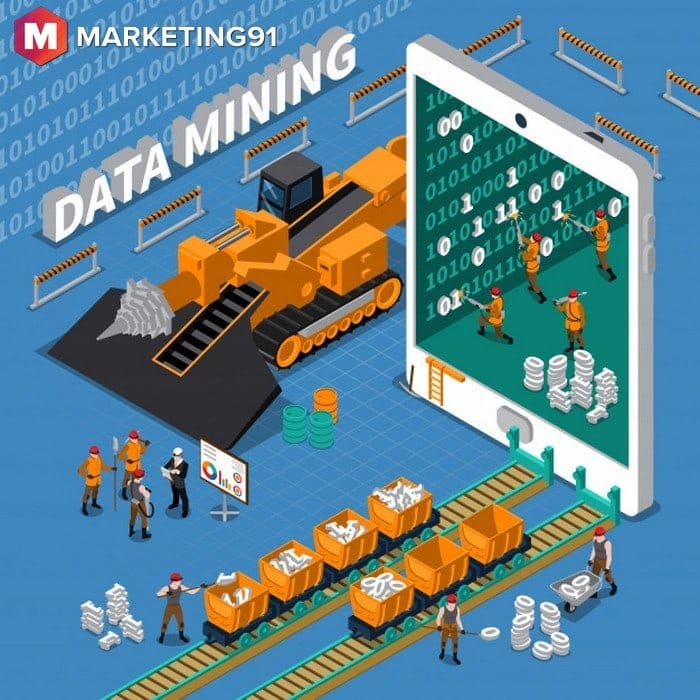Retail trade is one of the most competitive markets in the whole world, and retailers use various tactics to survive in this cut-throat competitive market.
They take the help of countless advertising, catalogs, pamphlets, flashy banners, and intrusive speaker announcement, etc. but the response from mass advertising is dropping day after day as people get annoyed by the continuous advertising on their face.
Therefore, organizations are working on to opt for customized offers for their customers as per their order record, which means offering the right product to the right customer at the right time and at the right price. This is possible with the help of data mining only.
Data mining is a concept of computer science, but it has played a significant role in the retail industry as it helps retailers to learn about the behavior and buying a pattern of their customers.
Retailers keep on collecting information about seasonal products sales, transactional data, and demographics, etc. the collected data is of no use if it is not converted in useful knowledge and converting data in knowledge requires proper mechanism.
This knowledge can help retailers to make better business-related decisions. Customized services help retailers to identify low-risk and high-profit customers and help in maintaining a pleasant and long-termed relationship with customers.
Data mining is proved to be one of the most important tools to identify useful information from the large pool of information collected over time.
Data mining is not only used in the retail industry, but it has a wide range of applications in many other industries also. Data mining is used to improve revenue generation and reduce the costs of business.
Data mining is the process of exploration and analysis of a large pool of information by total automatic or semiautomatic means. Various techniques are used collectively to design rules and models from databases. The buying behavior and choices of customers are changing rapidly, and it is a challenge for a retail manager to identify the means to retain their customers.
In such scenarios, data mining can help marketers to understand the changes in the behavior of customers and how to deal with them that change. In this article, you will learn about the life cycle of data mining and its applications in the retail industry.
Process of Data Mining in Retail Industry
Table of Contents
There are six phases in the life cycle of data mining
#1 To determine Business Opportunities:
The first phase of data mining focuses on determining the objectives and requirements of a project from the perspective of a business. After that, the knowledge from the collected data is used to establish data mining definition of the problem and preparing a preliminary plan to achieve desired objectives.
#2 Collection of relevant data for the data mining process:
In the data collection process, data is collected from orders placed by customers, sales of each product, products in inventory, etc. Data is collected initially to become familiar with the data and problems associated with it.
Data collected can be used to get insights about the data and to find out a various subset of data so that the hypothesis can be made for hidden information in the database.
#3 Sorting data to convert it into information:
Data preparation phase refers to the phase where all kind of activities takes place to construct final dataset using initial raw data.
#4 Application of various modelling techniques on data collected:
In this phase, different types of modelling techniques are chosen and applied, and their various parameters are calibrated to optimal values.
#5 Assessment of different applied Models:
In this phase, the entire model of data mining is reviewed and evaluated. All the steps executed in constructing model are evaluated and verified whether these steps work efficiently to achieve the desired objectives or not.
The end result of this phase is to reach a decision on the use of the data mining model.
#6 Deploying data to use:
The whole purpose of designed and creating a database is to increase knowledge obtained from the obtained data. The knowledge gained from the data is required to be organized and presented in such a way so that it can be easily understood and used by its users.
The complexity of data varies, it can be as simple as preparing a report, or it can be as complex as applying data mining process repeatedly across the different departments of the organization.
Applications of data mining in the retail industry
The importance of data mining is realized in the retail industry, and it can be used to get a competitive advantage. An enormous amount of data is collected in retail stores similar to the banking industry, but with the help of data mining, this data can be sorted, and useful information can be obtained.
In retailing, information obtained from data mining can be used to provide customers’ buying preferences and habits, products sales trends, seasonal variations, suppliers’ lead time and delivery performance, customer peak traffic period, and other predictive data to make proactive decisions. Followings are a few examples of how data mining can be used efficiently in the retail industry.
#1 Use of data mining to improve marketing methods:
Marketing is one of the most important parts of the retail industry. “Market Basket Analysis” is used by many retailers as a marketing method to find out the optimum location to promote a particular product. In simple words, we can say that it is the study of retail stock data movement at a particular Point-of-Sale.
This study can be used to support store layout, shelf space allocation, promotion effectiveness, and product location. It makes the use of information about the products already bought by customers to determine what kind of products they are likely to buy when given social offers or by simply making them aware about the existence of the products.
Having knowledge about where to place products and doing effective promotion of products can extensively increase store sales. Using data mining methods, a list of loyal customers can be prepared and provided them with loyalty cards to encourage other potential customers to become loyal for your store and its products.
In addition to this, you will also encourage similar behavior in your loyal customers and can establish a long-lasting relationship with them.
Other than that coupon printers are installed at the checkout counters of a supermarket store. These printers are especially beneficial for brand managers when they are not sure which customer to target for the products of their brand. These coupon printers can be used to print out a discount or offer a coupon when a particular product is purchased by customers.
#2 To minimize the risk:
Data mining can be used in the field of risk management in the retail industry. However, this area is least researched as compared to the other areas of the retail industry.
Data mining methods are used by retail organizations to determine which products are vulnerable at competitive risks or varying customers buying pattern.
Previous purchase history of customers is used to determine their loyalty for the brand. Data mining methods helps retailers to understand what their customers are doing so that they can make their strategies accordingly to remain competitive in the market and reduce risks of loss.
With the help of data mining methods, retailers can target those customers who are more likely to buy products of a certain brand and also can take decisions when and in which store to promote products whenever needed.
#3 To minimize fraud cases:
Fraud detection is important in the retail industry to run a smooth business. Fraud taking place at Point-of-sale is a major concern for retailers, but this can be reduced by using data mining.
According to the study, it is found that 38% loss of retail business occurs because of the dishonesty of retail employees and one-fourth of these frauds can be detected at Point-of-Sale.
Because of this reason, retailers put a lot of efforts to find out dishonest employees. Some supermarkets install CCTV cameras systems in addition to Point-of-sales data mining. Using these techniques, the retail manager can prevent situations where they have to collect evidence to convince an employee for stealing.
The suspected transaction can be retrieved from the data mining software, and CCTV footage can be referred to see what exactly happened during the transaction. This all can be done from the office, and they don’t have to be present in the store physically.
#4 Establishing the method to acquire new customers and using techniques to retain them:
The data mining methods can be used to acquire and retain customers in the retail industry. Data mining can help a retailer to understand the behavior of customers to survive the cut-throat competition in the market.
By studying the past purchase history of customers, they can prepare strategies to target customers and obtain business from them, and knowledge from data mining can also be used to stop customers from moving to their competitors.
In the end, we can say that data mining is an important tool to extract important information from the existing data and put the use of that knowledge to make better decisions. Data from different warehouses are sorted and put together in an acceptable and readable format to derive conclusions from it.
Data mining is not only used in the retail industry, but it has enormous uses in many other industries. It has various practical application in other industries such as detecting credit card frauds, analyzing the medical outcome, determining personal interests of wen users, determining the purchasing behavior of customers, and optimizing manufacturing processes, etc.
Because data mining can make use of past information to take appropriate steps in the future, it is widely used by many industries including retail industry, and constant research is being done on it make methods of data mining more efficient.
Liked this post? Check out the complete series on Retailing

